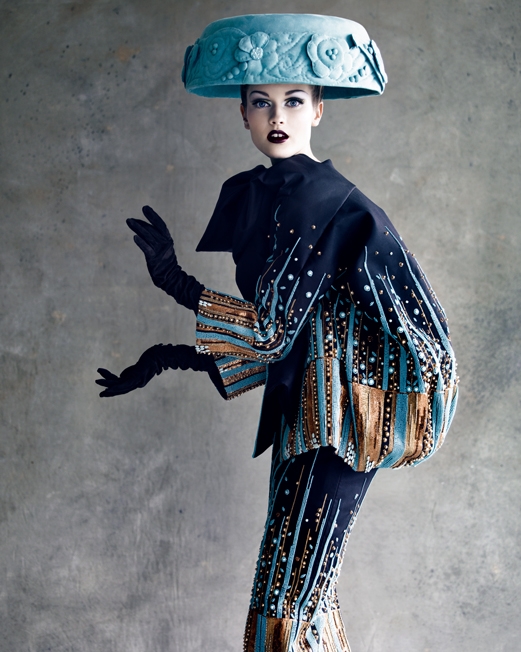January 21st is an epic day in fashion history. It is the day that two of fashion’s greatest designers, Cristobal Balenciaga and Christian Dior, were born, in 1895 and 1905 respectively. The two men are part of the small but illustrious pantheon of designers internationally recognized by a singular moniker, designers such as Lanvin and Chanel, whose names have endured long past their deaths. Today is the perfect day to celebrate the incredible talent and vision of the men responsible for two of the biggest globally-recognized fashion brands of the past fifty years and today. PART I: Christian Dior, born on this day in 1895.

It is worth mentioning that Christian Dior’s fate as one of the greatest couturiers of fashion history was solidified by not one, but two World Wars. The first brought him from his hometown of Normandy to Paris in the 1910s at the impressionable age of ten, while the aftermath of the second—in which he fought and served his country—provided the austere, spartan atmosphere in which Dior would inject his much-needed reverie of luxury and beauty, changing the face of fashion.

Dior owned an art gallery in Paris before he began his design career in the mid-1930s, selling his sketches to various couture houses before landing a job with couturier Robert Piquet. He served in the army for the first two years of WWII but returned to Paris, and couture, in 1941 to work for Lucien Lelong.[i] With the onset of the war in 1939, the high-glamour Hollywood-lux that defined 1930s fashion was vanquished, all extravagance repressed in beat with the harsh realities of war. Government regulations on clothing production further cemented the emergence of a simpler, more practical approach to dressing. Skirts narrowed, hemlines rose, silk stockings disappeared. Fashion’s creativity was to be found in the details, as designers discovered innovative ways to manipulate and work with the limited materials at their disposal. It was onto this ascetic, sober landscape that Dior burst forth like a fresh splash of paint on a Pollock canvas. Dior’s first collection for Spring 1947 was the wake-up call the world of fashion was waiting for: the war was over and Dior’s “New Look” was the future of fashion. Indeed, Dior’s distinctive brand of reshaping the female form would dominate fashion for the 1950s.


Dior’s first collection celebrated sumptuous, luxurious materials, yards of fabric, and highly structured silhouettes maintained by built-in, corset-like under-structures. The cinched-in waists, padded hips and full skirts of Dior’s ensembles were a direct rejection of, not just the war-imposed fashions of recent years, but the strides gained by the modern woman seeking comfortable clothing in the 1920s and 30s. Instead, the silhouette harkened back to the nineteenth century when structured, restrictive silhouettes were the height of fashion, the molding of the female form an undeniable marker of social status and sophistication. The Spring 1947 collection catapulted Dior to international fame. He would continue to dominate fashion unrivaled for the next ten years, until his untimely death in 1957. Today, Dior’s incredible, albeit brief, artistic oeuvre is a testament to the power of clothing—and the authority of one man—to become a defining element for an entire generation of women and their self-perceptions of all that is beautiful and feminine, two characteristics for which Dior’s name is synonymous to this day over fifty years after his death. Many of Dior’s successors are famous in their own right, especially Yves Saint Laurent (1957-1958), John Galliano (1997-2011) and currently Raf Simons (2012-present), who, by blending Dior’s signature style with their own artistic vision, have all ensured the continuance of Dior’s legacy on the modern stage and for years to come. See Part II on Cristobal Balenciaga here.



*Highlights from the Metropolitan Museum of Art’s Dior collection here. *Link to Life Magazine March 4, 1957 article on Dior here. [i] Where many couturiers including Coco Chanel and Elsa Schiaparelli shuttered their doors at the war’s onset, others such as Lucien Lelong remained open to battle the storm of the Nazi occupation of Paris. Lelong was especially instrumental in keeping Paris as the center of haute couture production when the Nazis wanted to move it to Germany.
this article does not say a work about Cristóbal Balenciaga… I dont know why it has this title
LikeLike
a word**
LikeLike
[…] Born on this day in fashion history: Christian Dior and Cristobal Balenciaga, Part I […]
LikeLike
[…] More on Christian Dior’s career can be found on the Art of Dress here. […]
LikeLike